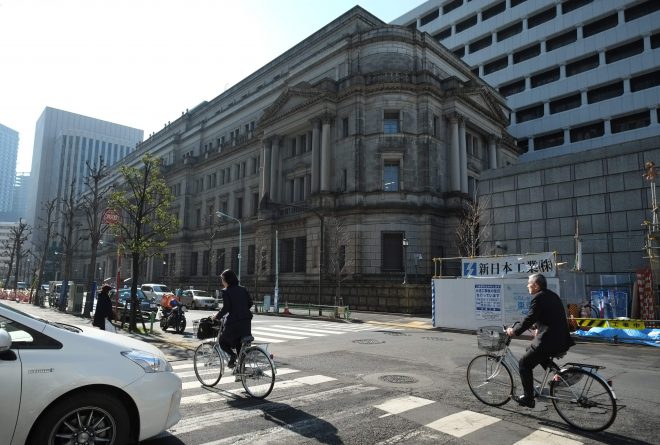5 years later, BOJ policy yet to beat deflationary mindset
April 5, 2018
Tokyo- Five years after the Bank of Japan introduced monetary easing of "another dimension," the grand social experiment to overcome deflationary mindset among the public in a short period has not achieved a complete success.
The BOJ initially vowed to achieve its 2 pct inflation target in two years, but the goal remains out of reach.
The BOJ's massive monetary easing, which marked its fifth anniversary on Wednesday, is likely to continue without clear prospects, with the timing of its exit from the ultraeasy policy remaining uncertain.
In April 2013, the BOJ decided to double the monetary base, or the combined balance of currency in circulation and commercial financial institutions' current account deposits at the central bank, within two years, after BOJ Governor Haruhiko Kuroda took the current position the previous month.
On the decision, Kuroda said that the BOJ "took all necessary measures at the moment, instead of employing its power in successive parts." He boasted the BOJ's new scheme, describing it as "monetary easing of another dimension."
The large-scale monetary easing, aimed at nurturing expectations for inflation and creating feelings among consumers that purchases before price hikes would have benefits, immediately led to the yen's weakening against other major currencies and higher stock prices in Japan.
Although prices saw gradual increases soon after the launch of the new monetary policy, year-on-year growth in the core consumer price index, excluding often-volatile fresh food prices, peaked out at around 1.5 percent, partly weighed down by a plunge in crude oil prices.
With the people's entrenched deflationary mindset unchanged, Japan saw no major expansion in consumption.
"The 2 percent inflation target could have been attained around summer 2014 if the initial momentum had continued," former BOJ Deputy Governor Kikuo Iwata said in a recent interview with Jiji Press.
"But the scenario was ruined by the consumption tax hike in April the same year," said Iwata, whose term of office expired last month.
After criticism grew over its negative interest policy, adopted in January 2016, the BOJ effectively acknowledged failure in its strategy to beat deflation in a short period and introduced a new monetary policy framework featuring yield curve control in September the same year.
The BOJ's massive monetary easing "has evolved after facing challenges several times" over the five years of its management, a senior official of the central bank said.
"It's not that a single policy can realize everything," BOJ Deputy Governor Masayoshi Amamiya, a key aide to Kuroda, said at a parliamentary session before taking his post on March 20.
After pushing back the expected timing of achieving its 2 pct inflation goal a total of six times, the BOJ currently believes that it will likely attain the mark around fiscal 2019, which starts in April next year.
"We need to continue our current easing, given that we are still some distance from our 2 pct inflation target," Kuroda said at Tuesday's meeting of the House of Representatives Committee on Financial Affairs.
With Kuroda set to enter a second five-year term as BOJ governor on Monday, an exit from its monetary easing of another dimension remains far away. Jiji Press
Latest Videos
- THE UNTOLD STORY EXPERT INSIGHTS INTO THE UKRAINE
- NEGOTIATING A NEW ORDER US RUSSIA TALKS ON UKRAIN
- Ukraine: A Pawn in the Geopolitical Game? Will Trump Intervene?
- US VP VANCE CRITICIZES EUROPEAN DEMOCRACIES AT MUNICH SECURITY CONFERENCE
- UNCOVERING THE WEB OF DECEIT: CIA INFILTRATION OF THE MEDIA
- SHIFTING SANDS: TULSI GABBARD’S CONFIRMATION AND THE EVOLVING GLOBAL LANDSCAPE
- FAUCI SCANDAL: A THREAT TO GLOBAL HEALTH AND DEMOCRACY






